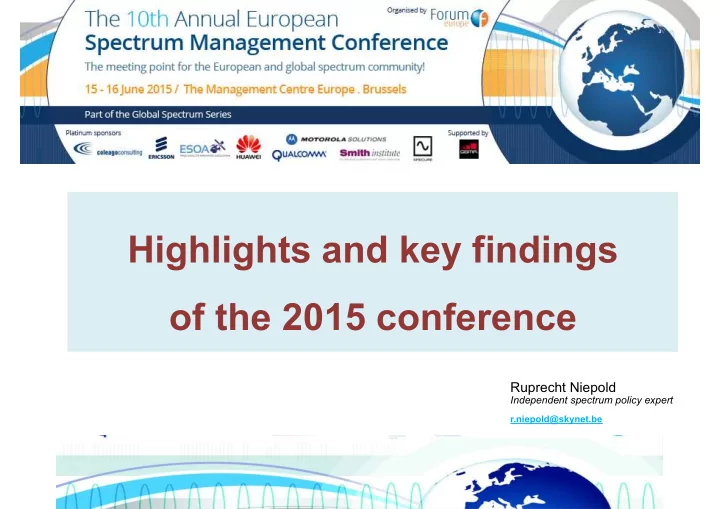

Highlights and key findings of the 2015 conference Ruprecht Niepold Independent spectrum policy expert r.niepold@skynet.be
The magic figure of 10 years • Stocktaking of achievements / failures, challenges for the future: o “ defendable achievements ” - “ Europe could do better ” - „ Europe is falling behind comparatively in key spectrum usages“ • Areas of concern: o spectrum delivering to its potential ? o enough spectrum for key usages ? o management methodology and cooperation amongst players ? • Signs of consensus: o agreement on crucial important spectrum and on importance to get management right o growing understanding and recognition of spectrum in context: spectrum as key ingredient in the digital world
How much Europe ? • DSM: an opportunity to debate, to reform and to change o clear anchorage: digital access as key enabler o reform of regulatory environment, with spectrum as key issue to be addressed o spectrum strategy, objectives and management methods (RSPP continuation ) • Open questions reviewed : o need for technical harmonisation recognised , but o how much coordination ? Sharing / experience best practices ? o how much enforcement mechanisms ? o adaptation / change of institutional set-up ? • Call for engagement to all parties to discuss the next environment ! o institutions: EP ? Council ? o constituencies
Market based approach • Consensus on some fundamentals o no unique model for auction design o “matching rules to objectives” is key o sharing of information and experiences with each other – rather than co-ordinating assignment approaches o usage conditions underlying auctions – e.g. duration of usage rights, coverage obligations - might need to be aligned o biasing influence by government organisations other than regulators (e.g. by Treasury) are counterproductive (EU guidelines to help regulators defend against such interference ?) • Discussion: • what conditions the price of spectrum ? • the importance of setting the reserve price at the right level
Wireless Broadband • The economic rationale to make WBB viable: o investment leveraging o improving the revenue situation: better offer, fostering demand o the impact of spectrum prices o better coherence of regulator environment re spectrum • Making sufficient spectrum available o 700 MHz: time frame (2020), regulatory certainty (harmonisation, availability), coordination (at an early stage) o additional spectrum ? o 5G: the new challenge identified (< 6GHz, millimetre waves) • Specific issues: • offloading: an opportunity, technical progress (LTE-LAA) • backhauling: a matter of concern (e.g. 5G), technical options, upstream planning and coordination needed.
Broadcasting / PPDR / Satellite / PMSE • Broadcasting: o the relevance of sufficient spectrum for broadcasting o implication of moving to <700 MHz: feasibility ? timing ? affordability ? Long term certainty of band <700 MHz ? • PPDR: o recognition of needs in Europe o some countries moving out of experience o EU coordinated approach for PPDR in 700MHz (too many options?) • Satellite o importance of satellite services recalled o satellite as backhaul o protecting satellite use of C-band • PMSE o Needs of PMSE recalled
WRC 15 • Identified as a key milestone ahead o on 700 MHz (A 1.2) seems to be on track o On identification additional IMT spectrum (A 1.1) : difficult, outcome critical o Many other AI discussed • ”Technical solutions are driven by political societal decisions”: o Coordination on technical issues delivers (CPG) o The importance of defining EU choices as input to WRC preparation process • Good cooperative effort EU / Africa o Coherence: 700MHz o To be settled: 3.4 -3.8 GHz o Room for inner regional pragmatic arrangements
Thank you for your active participation and see you again in 2016 for the 11th
Recommend
More recommend